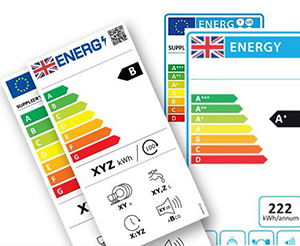- Information
- About HBH Woolacotts
- HBH Woolacotts Disposal Service
- Data Protection & GDPR Statement
- Terms and Conditions
- Staff Opportunities and Vacancies
- Price Promise
- Panasonic Store
- Plymouth Sony Centre
- Cookie Policy
- Privilege Club Newsletter Signup
- PaybyFinance - Frequently Asked Questions
- PaybyFinance Representative Example
- New Energy Labels
- Sustainability
- Magimix Giveaway Terms & Conditions
- Fixed and Sliding Hinges: What's the Difference?
- Custom Home Networking Installations
- HBH Woolacotts Privilege Club Terms
New Kitchen Appliance Energy Labels – March 2021
If you’ve been shopping for electricals recently, you’ll have noticed the multi-coloured energy labels on each product. As of March 2021, the energy labelling system is being updated to a much simpler format that will be easier to understand. The new ratings will be listed on a simple A to G ratings scale.
 It’s easy to think that energy efficiency ratings tell you how well a machine performs, however, that’s not the case and the energy ratings simply tell you about energy use and ultimately the cost to run. Products with poor energy ratings could still perform very well, if not better, than alternatives. They will however, use more energy and ultimately cost you more money to run.
It’s easy to think that energy efficiency ratings tell you how well a machine performs, however, that’s not the case and the energy ratings simply tell you about energy use and ultimately the cost to run. Products with poor energy ratings could still perform very well, if not better, than alternatives. They will however, use more energy and ultimately cost you more money to run.To try and make this easier to understand we’ve put together some information to help explain these ratings and what makes a good energy rating versus a bad rating.
How are energy ratings calculated?
Because appliances and products are designed to do very different jobs and work differently, the tests and comparative measures used to work out their energy efficiency are very different for each type of appliance. All appliances must have technical documents to prove the test results and justify their energy ratings.
Washing Machines
To work out a washing machine’s energy efficiency rating, the amount of energy the machine uses is calculated (in kilowatt hours) over 100 cycles. The measurements are based on energy consumption during an ‘Eco 40-60 wash’ which is a fairly standard cleaning programme for the majority of materials.
Washer Dryer
As there are two very different functions, the energy labels for washer dryers are split into two parts. The right side covers just a wash cycle and will be measure using the same kwh per 100 cycles as standard washing machines. The left side will show the energy rating for a wash and dry cycle.
Refrigeration
Energy labels for fridges and freezers are a little more complex and take in a variety of factors. Things like the type of appliance, how it works, the room’s ambient temperature and the size and quantity compartments all effect the overall energy rating.
To help ensure your refrigeration product runs as efficient as possibly you should always try and follow some key advice;
- Don’t over-fill your product
- De-ice your freezer regularly if it starts to build up.
- As refrigeration products are always on it's worth paying close attention to the energy label when shopping for a new product
Dishwashers
Dishwasher energy labels are similar to washing machines in that the overall rating is calculated by how much water and energy they consume over 100 cycles. This is tested using the Eco programme which is the most standard programme and mimics how the majority of dishwashers are used in households.
Cookers
Energy labels and rating calculations are staying the same as they been for cookers. When a cooker is tested, the size of the internal space is measured against the amount of energy it uses to heat a brick to 55°C. The less energy used to heat the brick, the better the cooker's energy rating!
There has always been a debate as to whether gas or electric is the best. When it comes to energy efficiency, the performance of gas versus electric tends to be roughly the same. Many people prefer the convenience of electricity, but with mains gas costing about 3 times less than electricity, gas can be a cheaper option.

